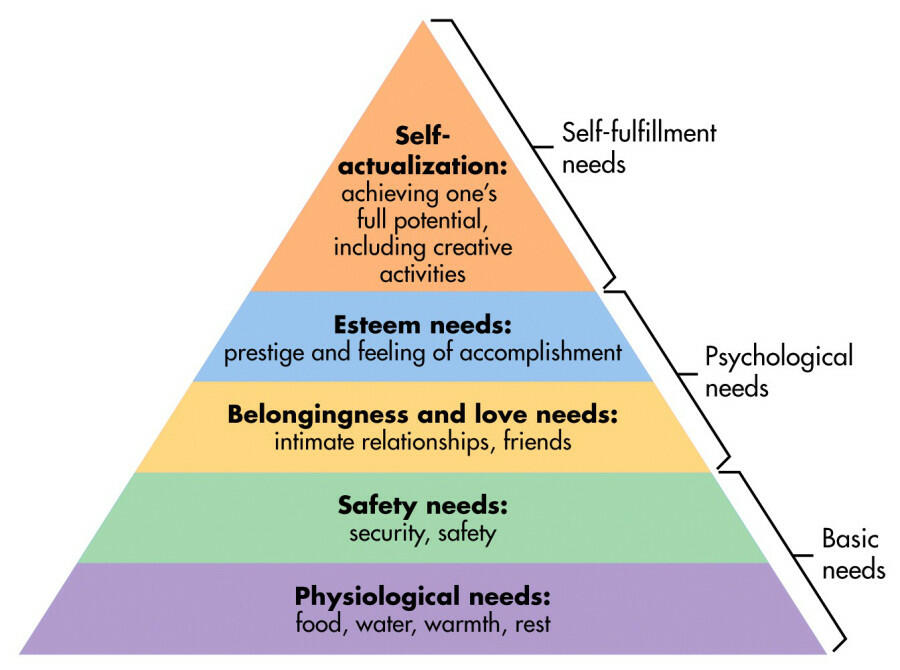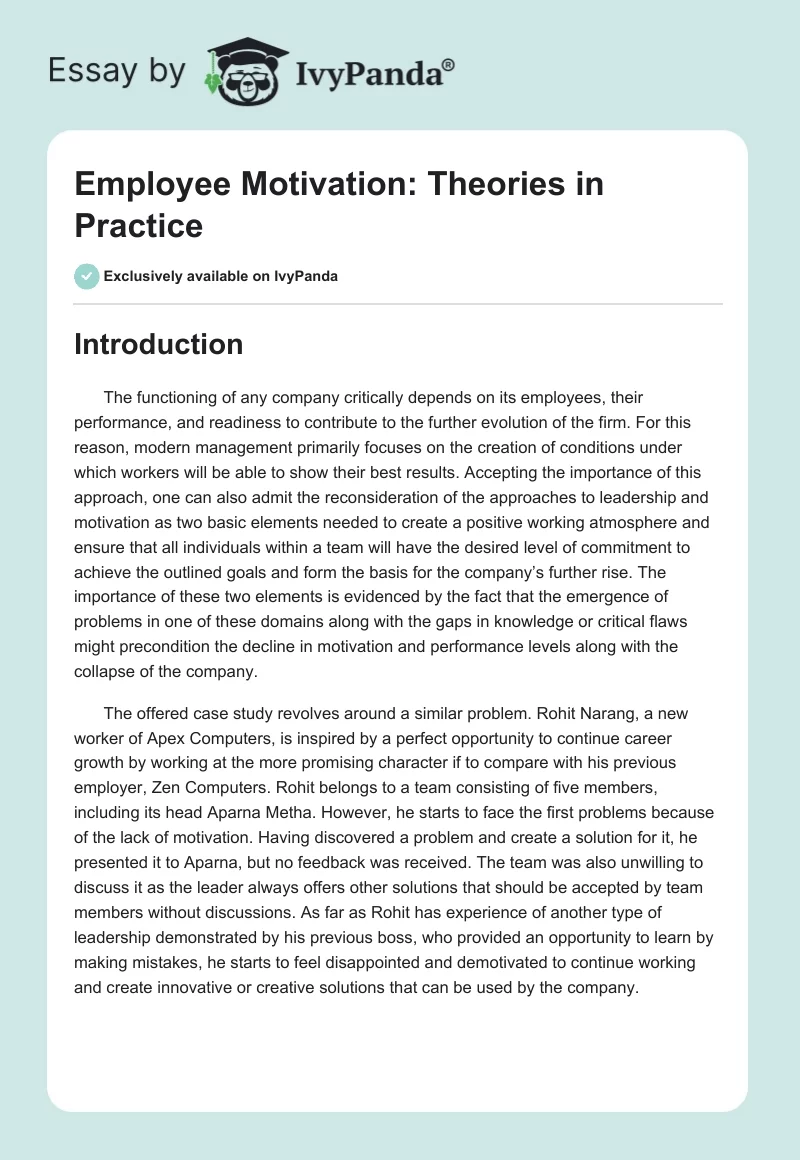Introduction
The functioning of any company critically depends on its employees, their performance, and readiness to contribute to the further evolution of the firm. For this reason, modern management primarily focuses on the creation of conditions under which workers will be able to show their best results.
Accepting the importance of this approach, one can also admit the reconsideration of the approaches to leadership and motivation as two basic elements needed to create a positive working atmosphere and ensure that all individuals within a team will have the desired level of commitment to achieve the outlined goals and form the basis for the company’s further rise.
The importance of these two elements is evidenced by the fact that the emergence of problems in one of these domains along with the gaps in knowledge or critical flaws might precondition the decline in motivation and performance levels along with the collapse of the company.
The offered case study revolves around a similar problem. Rohit Narang, a new worker of Apex Computers, is inspired by a perfect opportunity to continue career growth by working at the more promising character if to compare with his previous employer, Zen Computers. Rohit belongs to a team consisting of five members, including its head Aparna Metha. However, he starts to face the first problems because of the lack of motivation.
Having discovered a problem and create a solution for it, he presented it to Aparna, but no feedback was received. The team was also unwilling to discuss it as the leader always offers other solutions that should be accepted by team members without discussions. As far as Rohit has experience of another type of leadership demonstrated by his previous boss, who provided an opportunity to learn by making mistakes, he starts to feel disappointed and demotivated to continue working and create innovative or creative solutions that can be used by the company.
Theoretical Framework
Before analyzing this very situation and answering questions, it is critical to creating the theoretical background preceding the discussion and contributing to its improved understanding. As it has already been stated, the leadership and motivation issues play a critical role in this situation; moreover, they are interconnected, which means that the investigation of the problem is impossible without their comprehension.
Thus, the modern approach to leadership states that the central role of any leader is to inspire and motivate his/her followers to ensure the achievement of the best possible results and contribute to the future development of organizations (Gordon 56). There are also various leadership styles that can be utilized depending on the situation and the existing goals. The choice of the correct way to work with employees preconditions success and the ability of a team to accomplish existing tasks effectively (Gordon 78). In such a way, in this case, one can see essential flaws in this aspect as the level of commitment decreases.
Another factor touched upon in the case is motivation. It can be determined as people’s readiness to perform some actions or engage in various activities. It is usually associated with the generation of the particular benefit or satisfaction of a certain need, as all individuals have many motifs or cases for their actions. Speaking about organizations and teams, motivation also plays a critical role in their functioning as it guarantees high effectiveness and readiness to perform multiple tasks (Pinder 45).
At the same time, there is a clear understanding that there is a certain complexity peculiar to this sphere and a set of factors that impact motivation. From the case, it becomes clear that Rohit is inspired by the opportunity to engage in new, challenging, and interesting activities that can help him to grow professionally and build a career. These factors can be considered facilitators of motivation; however, the team leaders’ lack of desire to cooperate with a team decreases its levels.
The motivation of a person also depends on his/her current needs. Cogitating this issue, Maslow offers a specific hierarchy outlining factors that should be considered.

In accordance with this model, every individual has five types of demands, which are physiological, safety, belongingness and love, esteem, self-actualization needs (McLeod). Every worker remains in his/her own state of personal development, which means that there are different types of demands he/she has at the moment. However, only satisfaction of hierarchically lower needs can help to achieve the next stage and remain motivated (McLeod).
Applying this concept to the proposed situation and the question of motivation of leadership in general, it is possible to state that leaders’ main task is to watch that employees’ basic demands are met while there are also opportunities to satisfy needs for prestige, self-actualization, and career growth. Only under these conditions will workers demonstrate a high level of commitment and desire to perform their functions effectively.
Finally, the case also poses the question of climate or atmosphere within a collective as Rohit’s colleagues have a certain negative impact on his motivation and desire to work. Being sure that leadership style will not alter, they prefer to avoid creative solutions adhering to the recommendations of their leader. This factor deteriorates the atmosphere and contributes to the emergence of critical problems in the future.
What, according to you, were the reasons for Rohit’s disillusionment? Answer the question using Maslow’s Hierarchy of Needs.
In such a way, utilizing this theoretical framework, it can be stated that there were several reasons for Rohit’s disillusionment. Accepting the fact that the primary motive for leaving the previous job was the desire to self-realize and build a more successful career, the absence of opportunities for self-realization can be considered the primary factor is limiting his motivation to work effectively.
The utilization of the inappropriate leadership style by Aparna also contributes to the deterioration of the climate within a collective, which is also one of the factors that decrease Rohit’s desire to engage in new work and makes him think about the previous employer who provided workers with the chance to cooperate, discuss, and evolves by using creative approaches.
Applying the concept of Maslow’s hierarchy of needs to the case, it is possible to state that Rohit has already fulfilled his basic demands, such as physiological and safety ones. The major reason for his transfer to other work was the desire to build a successful career or self-actualization and esteem demands (McLeod).
The existence of opportunities to become a member of a team that creates new approaches together is an ideal motivator for Rohit. However, Aparna’s disregard of the team’s ideas and autocratic leadership style reduces motivation levels as there are no more chances to self-realize and grow professionally. For this reason, Rohit experiences some hardships and is not able to find other factors that can motivate him to work better.
What should Rohit do to resolve his situation? What can a team leader do to ensure high levels of motivation among his/her team members?
One of the possible ways to resolve the situation for Rohit is direct and open communication with his leader to share his problems and explain the negative impact of the selected leadership style on the whole collective. Trustful relations between all employees are the key to the achievement of positive results, which means that the initiation of the group discussion of the existing problems can help to make Aparna think about altering the current approach.
To achieve high levels of motivation among group members, the leader should adhere to the transformational leadership style as it provides opportunities for all employees to engage in debates about topical problems and create an innovative solution that would contribute to the achievement of organizational goals (Gordon 123). A gradual increase in motivation levels should be one of Aparna’s major tasks.
Conclusion and Recommendations
Altogether, the given case proves the increased importance of motivation and leadership for the work of organizations. The absence of the opportunity to satisfy current needs might result in the reduction of employees’ desire to demonstrate high-performance levels or solve some tasks creatively. For this reason, it can be recommended to use flexible and inclusive approaches that can help to engage all workers in problem-solving activities and demonstrate to them the importance of their contribution to the further evolution of the company and it’s becoming a leader in the market.
Utilization of this approach would help to achieve much better results and ensure that all members of the team will remain motivated to do their best. Additionally, leaders should correctly realize the peculiarities of their teams and monitor their states to be ready to introduce needed changes to avoid stagnation or deterioration of the climate within a collective.
Works Cited
Gordon, Jon. The Power of Positive Leadership: How and Why Positive Leaders Transform Teams and Organizations and Change the World. Wiley, 2017.
McLeod, Saul. “Maslow’s Hierarchy of Needs,”Simply Psychology, 2018, Web.
Pinder, Craig. Work Motivation in Organizational Behavior. 2nd ed., Routledge, 2015.


